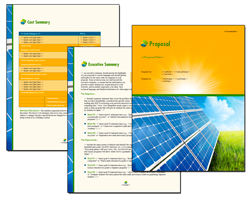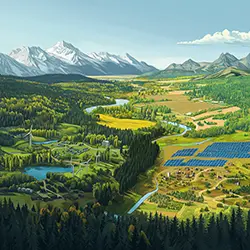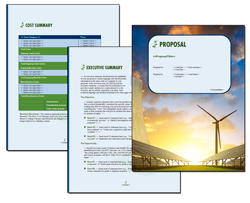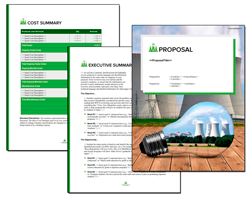
How to Write an Energy Proposal: Complete Guide
The renewable energy sector is experiencing unprecedented growth, with projects requiring millions in investment and careful regulatory navigation. Learning how to write an energy proposal effectively can determine whether your company secures lucrative contracts or watches opportunities slip away to competitors.
Well-written energy proposals serve as the foundation for successful projects ranging from residential solar installations to massive wind farms on federal lands. They must address complex requirements, including the National Environmental Policy Act compliance, greenhouse gas emissions reduction targets, and detailed financial projections that satisfy both stakeholders and funding agencies. At the outset of any energy proposal, it is crucial to have a clear plan that outlines the project scope and approach, ensuring all parties understand the objectives and steps involved.
In recent years, the energy industry has evolved dramatically. Federal funding opportunities have expanded, new technologies have emerged, and regulatory processes have become more sophisticated. Recent legislation has significantly influenced the requirements and opportunities for energy proposals, especially regarding national security and permitting reform, making it essential to stay updated on new laws and compliance standards. Whether you're developing proposals for energy efficiency upgrades, renewable energy installations, or traditional energy projects, understanding how to write an energy proposal that wins requires mastering both technical specifications and business fundamentals.
This comprehensive guide will take you through every aspect of energy proposal writing, from initial client assessment to final project implementation. You'll discover the essential components that evaluators look for, learn how to present compelling financial analysis, and understand the regulatory frameworks that can make or break your proposal's success.
What is an Energy Proposal?

An energy proposal is a comprehensive document that outlines a specific energy project, installation, or efficiency program designed to meet a client's objectives while demonstrating technical feasibility and financial viability. These proposals serve as both sales tools and project blueprints, requiring careful balance between persuasive presentation and technical accuracy.
Energy proposals encompass a broad range of applications in today's market. They cover renewable energy systems, including solar panels, wind installations, and geothermal solutions that help organizations reduce their carbon footprint while achieving economic growth. Traditional energy solutions, such as natural gas systems and efficiency upgrades, also require detailed proposals that address environmental impact and regulatory compliance.
The extent of energy proposals goes beyond simple equipment installation, covering a wide range of actions and requirements. They must demonstrate how proposed projects align with broader objectives, including national security considerations, public health benefits, and climate change mitigation goals. Modern proposals often address complex requirements related to federal land use, forest service coordination, and domestic mining considerations for critical minerals used in renewable energy technologies. Specific issues such as regulatory burdens, permitting, and compliance are addressed within proposals to ensure all necessary standards are met.
Different types of energy proposals serve various market segments and funding sources. Solar installation proposals typically focus on residential and commercial applications, emphasizing immediate cost savings and long-term financial benefits. Energy audit proposals assess existing systems and recommend efficiency improvements that create jobs while reducing operational costs. Commercial energy solutions proposals address large-scale implementations that may require extensive permitting processes and environmental impact assessments. In addition to these, proposals may include other types of energy solutions or technologies, such as battery storage, hydrogen systems, or advanced grid management, highlighting the diversity of available options.
Government energy program proposals represent another crucial category, often targeting federal funding opportunities that support innovation and development in clean energy technologies. These proposals must demonstrate alignment with policy objectives while providing detailed research methodologies and measurable outcomes that benefit the broader energy sector.
Energy Sources and Environmental Impact

Addressing environmental impact is a central component of any successful project proposal. Proposed projects are designed to advance energy efficiency and significantly reduce greenhouse gas emissions, in full alignment with the guidelines set forth by the National Environmental Policy Act (NEPA). By prioritizing the integration of solar panels and other renewable energy sources, projects aim to minimize their carbon footprint and set a benchmark for sustainable development in the sector.
A key objective of projects is to implement energy-efficient building and housing programs that not only lower energy consumption but also create jobs and drive economic growth. These initiatives are structured to support both immediate and long-term benefits, including reduced operating costs, improved public health, and a positive impact on the environment. The project's descriptions emphasize the importance of responsible land management, ensuring that federal lands are protected from environmental degradation through careful planning and adherence to best practices.
The permitting process for the proposed projects will be meticulously managed in accordance with federal regulations, ensuring that all environmental impacts are thoroughly assessed and mitigated. This approach guarantees that the projects will be implemented responsibly, with a focus on protecting natural resources and supporting sustainable land management. By adopting advanced energy-efficient technologies and practices, the projects will reduce reliance on non-renewable energy sources and help mitigate the effects of climate change.
Budget allocation is a critical aspect of the project's success. Funds will be directed toward the development and implementation of innovative energy-efficient technologies, comprehensive research and development efforts, and robust stakeholder engagement and capacity building initiatives. The project timeline is structured over a three-year period, with clear milestones for research, development, and construction phases, ensuring that objectives are met efficiently and effectively.
The project proposal serves as a leading example of how energy-efficient building and housing programs can be implemented to achieve substantial reductions in greenhouse gas emissions while promoting sustainable economic development. By creating jobs, stimulating local economies, and reducing overall energy consumption, these projects are poised to deliver a positive impact that extends well beyond their immediate scope.
In recent years, there has been a growing emphasis on energy efficiency and the reduction of greenhouse gas emissions across the industry. The proposed projects are at the forefront of this movement, leveraging the latest technologies and best practices to support a more sustainable future. Success will be measured by the project's ability to deliver measurable reductions in emissions, promote energy efficiency, and create lasting economic and environmental benefits.
All activities will be conducted in strict accordance with federal regulations and the guidelines outlined in the National Environmental Policy Act. The project's environmental impact will be continuously assessed, with additional resources allocated as needed to support research, stakeholder engagement, and capacity building. This commitment to responsible implementation ensures that the projects not only meet but also exceed regulatory expectations.
Ultimately, the project proposal highlights the critical role of energy-efficient building and housing programs in addressing climate change and promoting sustainable development. By focusing on reducing greenhouse gas emissions, enhancing energy efficiency, and creating economic opportunities, the project stands as a model for future initiatives seeking to balance environmental stewardship with economic growth.
Here are some related samples included in every downloadable Proposal Pack
The AI Writer generates a first draft of these templates - customized to your company, client, and project - in just minutes, giving you a head start on editing. Get any Proposal Pack or Proposal Kit Professional, and all of these samples, and the AI Writer are included.
Here are some related downloadable templates
The AI Writer generates a first draft of these templates - customized to your company, client, and project - in just minutes, giving you a head start on editing. Get any Proposal Pack or Proposal Kit Professional, and all of these templates and the AI Writer are included.
Essential Components of an Energy Proposal
Executive Summary and Company Introduction
The executive summary serves as your proposal's most critical section, providing evaluators with a compelling overview of your company's energy expertise and the proposed project's key benefits. This section must capture attention immediately while establishing credibility through concrete achievements and relevant experience.
Write an opening that highlights your organization's track record since its founding, emphasizing specific milestones in energy project delivery. Include quantifiable achievements such as total megawatts installed, energy efficiency improvements delivered, or greenhouse gas emissions reductions achieved across your project portfolio. These metrics demonstrate practical experience while supporting your capability to deliver results.
Professional certifications add substantial credibility to your company's introduction. NABCEP (North American Board of Certified Energy Practitioners) certifications for solar installations, BPI (Building Performance Institute) credentials for energy efficiency work, and relevant engineering licenses show commitment to industry standards. Document these qualifications prominently while explaining how they benefit the specific project under consideration.
Your unique value propositions should address what sets your approach apart from competitors. Whether offering extended 25-year warranties, innovative financing options, proprietary technology solutions, or specialized expertise in regulatory processes, these differentiators must connect directly to client needs and project success factors.
Include a brief company timeline that showcases major milestones, industry awards, and recognition received in the energy sector. This historical context helps evaluators assess your organization's stability and growth trajectory, which is particularly important for long-term projects requiring ongoing support and maintenance.
Client Needs Assessment and Analysis
Thorough client assessment forms the foundation of any successful energy proposal, requiring detailed analysis of current energy consumption patterns, operational requirements, and strategic objectives. This assessment demonstrates your understanding of their specific challenges while positioning your solution as the optimal response.
Document current energy usage using 12-24 months of utility bills and consumption data, analyzing seasonal variations, peak demand periods, and cost trends. This historical analysis reveals opportunities for energy efficiency improvements and helps establish baseline metrics for measuring future performance. Include graphs and charts that clearly illustrate usage patterns and identify areas where your proposed solution will create the most significant impact.
Energy goals vary dramatically across clients, from cost reduction targets of 20-40% to carbon footprint reduction objectives aligned with corporate sustainability commitments. Some organizations prioritize energy independence to reduce vulnerability to utility rate increases, while others focus on regulatory compliance or public relations benefits. Understanding and documenting these priorities ensures your proposal addresses what matters most to decision-makers.
Property characteristics significantly affect project feasibility and design requirements. Assess roof conditions for solar installations, electrical panel capacity for system integration, available space for equipment installation, and local zoning regulations that might affect project approval. Document any constraints or challenges that could affect implementation timelines or require additional investment.
Address client priorities, including preferred payback period ranges, aesthetic concerns that might influence system design, budget constraints that affect equipment selection, and operational requirements that could impact system configuration. This comprehensive assessment shows attention to detail while building confidence in your ability to deliver a solution that meets their specific needs.
Financial Analysis and Cost Breakdown

Transparent financial analysis represents one of the most crucial elements in energy proposal writing, as clients and funding agencies scrutinize costs carefully to assess value and feasibility. Your pricing structure must be comprehensive, accurate, and clearly justified to build confidence in your budget projections.
Equipment costs should be itemized with current market pricing, typically ranging from $0.50 to $1.00 per watt for solar panels, depending on efficiency ratings and manufacturer warranties. Include detailed specifications for major components such as inverters, mounting systems, monitoring equipment, and energy storage systems, if applicable. Provide model numbers, efficiency ratings, and warranty terms for each significant component to demonstrate thorough planning and quality selection.
Installation costs encompass multiple elements beyond basic labor, including permits, electrical work, interconnection fees, and specialized equipment required for safe installation. Break down these costs separately to show transparency and help clients understand where their money is invested. Include provisions for unexpected conditions that might require additional work, such as electrical panel upgrades or structural reinforcements.
Soft costs represent a significant portion of total project expenses, covering design work, engineering analysis, project management, sales commissions, and administrative overhead. These costs typically account for 15-25% of total project value and must be clearly documented to justify your pricing structure. Explain how these investments ensure project success and regulatory compliance.
Provide total project costs with price per watt calculations ($2.50-4.00/watt installed for typical solar projects) and comparison to regional market averages. This context helps clients assess whether your pricing represents fair market value while understanding factors that might justify premium pricing, such as superior equipment, extended warranties, or enhanced service packages.
Financial Benefits and Incentive Analysis
Compelling financial analysis extends beyond initial costs to demonstrate long-term value through energy savings, available incentives, and return on investment calculations. This analysis must be conservative, well-documented, and based on verifiable data to maintain credibility with sophisticated evaluators.
Calculate monthly and annual energy bill savings using current utility rates and applicable net metering policies, which vary significantly by location and utility provider. Include escalation factors for future utility rate increases, typically 2-4% annually, to show how savings grow over time. Present these calculations in easy-to-understand tables and graphs that illustrate both immediate and cumulative benefits.
Available incentives can dramatically affect project economics and must be thoroughly researched and accurately presented. The 30% federal tax credit remains a significant driver for renewable energy projects, while state rebates, USDA grants for rural areas, and utility-specific programs can provide additional financial benefits. Document eligibility requirements, application deadlines, and any limitations that might affect incentive availability.
Payback period analysis typically shows full cost recovery within 6-10 years for well-designed energy systems, depending on local utility rates, available incentives, and system performance. Calculate this metric using conservative assumptions about system performance and energy prices to ensure realistic expectations. Include sensitivity analysis showing how different scenarios might affect payback periods.
Present 20-year net present value calculations that account for inflation, discount rates, and equipment degradation over time. This long-term financial analysis helps clients understand total investment returns while demonstrating the economic benefits of energy projects beyond simple payback calculations.
Financing options significantly affect project accessibility and should be presented clearly with associated terms and conditions. Cash purchases offer the highest long-term returns, solar loans enable immediate ownership with manageable payments, leases reduce upfront costs but limit incentive availability, and power purchase agreements (PPAs) eliminate upfront investment while providing immediate savings.
Implementation Timeline and Process

Project implementation requires careful coordination of multiple activities, regulatory approvals, and stakeholder communications. Streamlining operations is essential to ensure project efficiency and regulatory compliance. A realistic timeline demonstrates your understanding of project complexities while setting appropriate expectations for clients and team members.
The pre-installation phase typically requires 2-6 weeks, depending on local permitting requirements and utility interconnection procedures. During this phase, it is important to conduct energy production estimates or site assessments to accurately plan system size and performance. This phase includes permit applications that must comply with local building codes, electrical standards, and zoning requirements. Utility interconnection applications initiate the approval process for connecting your system to the electrical grid, which may require technical studies for larger installations.
Equipment procurement must be coordinated with installation schedules to minimize project delays while ensuring equipment arrives in proper condition. Long lead times for specialized equipment like transformers or custom mounting systems can affect project timelines significantly, particularly during periods of high market demand or supply chain disruptions.
Installation schedules vary based on project size and complexity, with residential solar installations typically requiring 1-3 days while commercial projects may need several weeks. Site preparation includes establishing safe work areas, protecting existing structures, and ensuring proper access for equipment and personnel. Mounting system installation requires precise measurement and secure attachment to structural elements.
Electrical work represents a critical project phase requiring licensed electricians and careful coordination with utility requirements. This phase includes installing disconnect switches, grounding systems, monitoring equipment, and final connections to the electrical panel. All electrical work must meet local codes and utility standards to ensure safe operation and regulatory compliance.
Post-installation activities include final inspections by local authorities, utility approval for interconnection, system commissioning to verify proper operation, and performance monitoring setup. Provide realistic timelines from contract signing to system activation, typically 1-4 months, depending on local regulatory processes and utility procedures.
As part of the permit application and regulatory approval process, you must submit all required documents, reports, or applications to the relevant authorities to ensure compliance and timely approvals.
Address potential delays that could affect project schedules, including weather conditions, permit approval delays, equipment delivery issues, or utility interconnection complications. Having contingency plans demonstrates professional project management while helping clients understand factors beyond your direct control.
Warranties, Maintenance, and Support

Long-term value propositions strengthen energy proposals by addressing client concerns about equipment reliability, ongoing performance, and service availability. Comprehensive warranty and support programs demonstrate confidence in your solution while providing peace of mind for significant investments.
Equipment warranties represent manufacturer commitments to product quality and performance over extended periods. Solar panel manufacturers typically provide 25-year performance guarantees, ensuring minimum power output levels throughout the system's operational life. Inverter warranties range from 10-25 years, depending on technology type, with string inverters typically offering shorter coverage than power optimizers or microinverters.
Installation workmanship coverage protects clients against defects in mounting systems, electrical connections, and structural modifications performed during project installation. These warranties typically cover 5-10 years and should include provisions for correcting any installation-related issues without additional cost to the client.
Monitoring systems enable real-time performance tracking, issue identification, and optimization opportunities throughout the system's operational life. Modern monitoring platforms provide mobile app access, automated alerting for performance problems, and detailed production reports that help clients understand their investment's value. Include examples of monitoring dashboards and explain how data access empowers informed decision-making.
Maintenance requirements for energy systems are generally minimal but must be clearly communicated to ensure optimal long-term performance. Annual inspections verify system safety and performance while identifying opportunities for cleaning, component replacement, or system optimization. Panel cleaning schedules depend on local environmental conditions, with some areas requiring quarterly attention while others need minimal intervention.
System optimization services can enhance performance through firmware updates, component replacements, or configuration adjustments as technology evolves. These services demonstrate an ongoing commitment to maximizing client value while providing opportunities for additional revenue through service agreements.
Provide clear contact information for customer support, including the designated point of contact for clients seeking assistance with their energy systems, local service technicians, 24/7 monitoring capabilities, and guaranteed response times for service requests. Response time commitments vary based on issue severity, with safety concerns requiring immediate attention while routine maintenance can be scheduled during normal business hours.
Document your organization's service capabilities, including geographic coverage areas, local technician availability, parts inventory management, and escalation procedures for complex technical issues. This operational detail builds confidence in your ability to provide ongoing support throughout the system's operational life.
Proposal Best Practices and Professional Presentation
Professional presentation significantly affects proposal evaluation, with clear formatting, compelling visuals, and error-free content demonstrating attention to detail that evaluators associate with quality project execution. Modern proposal tools enable interactive presentations that engage clients while streamlining approval processes.
Professional proposal software like Proposal Kit provides templates designed specifically for energy projects while enabling customization for client-specific requirements. These platforms support interactive presentations with embedded videos, such as PowerPoint, that accelerate approval processes while providing professional polish that distinguishes your proposals from competitors.
High-quality visuals communicate complex technical concepts more effectively than text descriptions alone. Include aerial property photos showing proposed system locations, detailed system renderings that illustrate the final appearance, and performance charts demonstrating expected energy production and savings over time. Professional photography and computer renderings create positive impressions while helping clients visualize completed projects.
Thorough proofreading eliminates errors that can undermine credibility and suggest careless attention to detail. Review technical specifications for accuracy, verify financial calculations, and ensure consistent formatting throughout the document. Grammar and spelling errors distract from your message while raising questions about the quality of your technical work.
Customization demonstrates a genuine interest in each client's specific needs rather than generic solutions applied universally. Include property-specific details, reference conversations with key decision-makers, and address unique requirements or constraints that affect project design. This personalized approach shows investment in understanding their situation while building relationships that extend beyond individual transactions.
Response time affects client satisfaction and competitive positioning, with faster turnaround often influencing selection decisions. Establish internal processes that enable proposal delivery within 48-72 hours of site assessment completion while maintaining quality standards. Quick response demonstrates efficiency and eagerness to serve while providing competitive advantages in time-sensitive situations.
Follow-up procedures ensure proposals receive appropriate consideration while maintaining professional relationships regardless of immediate outcomes. Establish systematic approaches for staying in contact with prospective clients, sharing relevant information about incentive changes or technology improvements, and positioning your organization for future opportunities as situations evolve.
 Proposal Kit Professional provides the most content, including legal contracts and a free design theme pack. Plus, advanced software features include custom branding and customizable quoting databases.
Proposal Kit Professional provides the most content, including legal contracts and a free design theme pack. Plus, advanced software features include custom branding and customizable quoting databases. Proposal Pack for Any Business covers this type of proposal and includes samples. There are also some commonly used specialty design themes available:
Proposal Pack for Any Business covers this type of proposal and includes samples. There are also some commonly used specialty design themes available:Photo Design Proposal Packs
Line Art Design Proposal Packs
 Proposal Pack Energy #1
Proposal Pack Energy #1 Proposal Pack Energy #2
Proposal Pack Energy #2 Proposal Pack Energy #3
Proposal Pack Energy #3 Proposal Pack Energy #4
Proposal Pack Energy #4 Proposal Pack Energy #5
Proposal Pack Energy #5 Proposal Pack Energy #6
Proposal Pack Energy #6 Proposal Pack Energy #7
Proposal Pack Energy #7 Proposal Pack Energy #8
Proposal Pack Energy #8 Proposal Pack Environmental #1
Proposal Pack Environmental #1 Proposal Pack Environmental #2
Proposal Pack Environmental #2 Proposal Pack Environmental #3
Proposal Pack Environmental #3 Proposal Pack Mining #1
Proposal Pack Mining #1 Proposal Pack Outdoors #2
Proposal Pack Outdoors #2
Energy Proposal Templates and Tools
Industry-standard software streamlines proposal creation while ensuring technical accuracy and professional presentation. These tools integrate design capabilities, financial modeling, and proposal generation into comprehensive platforms that reduce development time while improving consistency and quality.
Aurora Solar provides comprehensive design and proposal capabilities specifically developed for solar installations, integrating satellite imagery, shading analysis, and electrical system modeling with financial projections and professional proposal generation. The platform's 3D modeling capabilities enable realistic visualizations that help clients understand proposed installations while automated calculations ensure technical accuracy.
HelioScope offers advanced modeling capabilities for complex solar installations, particularly valuable for commercial and utility-scale projects requiring detailed electrical analysis and performance optimization. The platform's sophisticated modeling engine accounts for module mismatch, inverter clipping, and environmental factors that affect system performance.
EnergyGauge specializes in building energy efficiency analysis, enabling comprehensive audits and improvement recommendations for residential and commercial properties. The software integrates building modeling with equipment efficiency analysis to identify optimal improvement strategies while calculating costs and benefits for various upgrade options.
Professional template resources are available through Proposal Kit. These templates incorporate industry best practices while ensuring compliance with regulatory requirements and professional standards. Customize these templates with your branding and specific service offerings while maintaining proven structural elements.
AI-powered tools are emerging to accelerate proposal creation while maintaining customization and accuracy standards. These platforms can analyze client requirements, generate preliminary designs, and create draft proposals that professionals can refine and customize. However, human expertise remains essential for technical accuracy, regulatory compliance, and client relationship management.
The Proposal Kit includes an AI-driven RFP analysis that can turn an RFP into a first-draft proposal rapidly. The final proposal can also be turned into a presentation-ready PowerPoint slideshow.
Required documentation checklists ensure comprehensive information gathering that supports accurate proposals and smooth project implementation. Essential documents include recent utility bills for energy usage analysis, property surveys showing available installation areas, electrical panel specifications for integration planning, and site photos documenting existing conditions and potential constraints.
Develop standardized workflows that ensure consistent information gathering, analysis procedures, and proposal development processes. This systematization reduces errors while improving efficiency and enabling quality control measures that maintain professional standards across all proposals.
Training and certification programs enhance proposal quality by improving technical knowledge, sales skills, and industry awareness. Organizations like NABCEP, IREC (Interstate Renewable Energy Council), and equipment manufacturers offer education programs that strengthen professional capabilities while demonstrating commitment to industry excellence.
Market research tools provide current pricing information, incentive updates, and competitive intelligence that inform proposal development and pricing strategies. Regularly updated databases help ensure accurate cost estimates while identifying opportunities for competitive advantages through superior value propositions or innovative approaches.
Quality assurance procedures should include technical review by qualified engineers, financial verification by accounting professionals, and client communication review by sales management. This multi-level review process catches errors before proposals reach clients while ensuring consistency with company standards and client expectations.
Version control systems prevent confusion and errors when multiple team members contribute to proposal development. Document management platforms enable collaborative editing while maintaining revision histories and ensuring final proposals represent approved content and current pricing information.
Integration capabilities between different software platforms streamline workflows while reducing data entry errors. Modern proposal tools often integrate with CRM systems, financial software, and project management platforms to create comprehensive business processes that extend from initial client contact through project completion and ongoing support.
Key Takeaways

Successful energy proposals require a strategic blend of technical expertise, financial analysis, and professional presentation that addresses both immediate client needs and long-term value propositions. The most effective proposals demonstrate a clear understanding of regulatory requirements, market conditions, and client priorities while providing comprehensive solutions that create measurable benefits. It is also essential to consider the consequences of policy decisions and project actions, as these can significantly impact the environment, economy, and national security.
Technical credibility forms the foundation of winning proposals, requiring accurate system design, realistic performance projections, and compliance with relevant codes and standards. Financial analysis must be conservative yet compelling, showing clear pathways to positive returns while accounting for available incentives and long-term value creation.
Professional presentation increasingly relies on modern software tools that enable interactive proposals, 3D visualizations, and streamlined approval processes. However, technology cannot replace the fundamental requirement for customization, accuracy, and attention to client-specific needs that distinguish exceptional proposals from generic submissions.
The regulatory landscape continues evolving with new requirements related to environmental impact, grid integration, and safety standards. Staying current with these changes while understanding their implications for project development and proposal requirements represents an ongoing professional responsibility.
Market conditions, including equipment pricing, incentive availability, and financing options, change frequently and require continuous monitoring to ensure proposal accuracy and competitive positioning. Building relationships with equipment suppliers, financing partners, and regulatory agencies supports accurate, timely proposal development.
Learning how to write an energy proposal effectively requires practice, continuous education, and systematic approaches to information gathering, analysis, and presentation. Start with proven templates and industry best practices while developing your expertise through training programs and professional certification opportunities.
The energy sector's continued growth creates expanding opportunities for professionals who master proposal development skills. Well-written proposals not only address client needs but also help protect energy security, environmental integrity, and economic stability. Whether pursuing residential solar installations, commercial efficiency upgrades, or utility-scale renewable energy projects, the ability to create compelling, accurate, and professional proposals remains essential for business success in this dynamic industry.
Remember that each proposal represents an opportunity to build long-term client relationships that extend far beyond individual projects. Focus on delivering value, maintaining professional standards, and continuously improving your capabilities to achieve sustained success in the competitive energy marketplace.



 Cart
Cart
 Are you just looking for a template, sample, or software for your energy industry proposals? Click these links to skip down the page and get right to it.
Are you just looking for a template, sample, or software for your energy industry proposals? Click these links to skip down the page and get right to it.













 Facebook
Facebook YouTube
YouTube Bluesky
Bluesky Search Site
Search Site